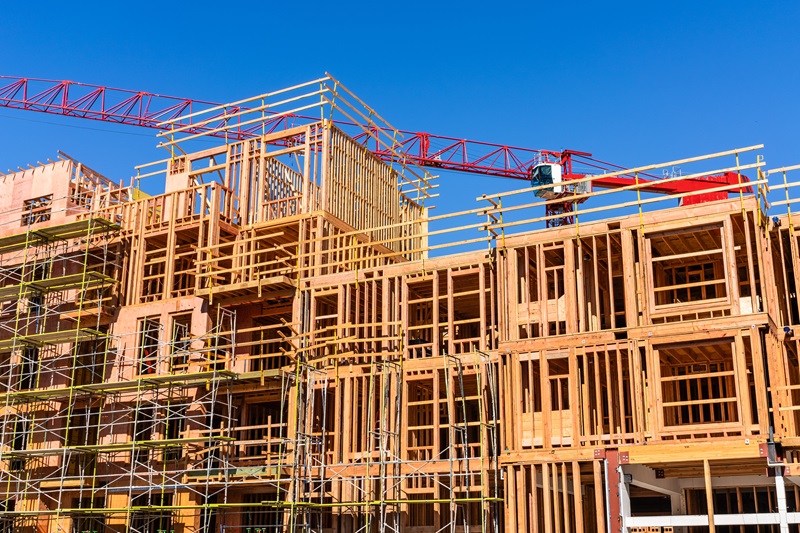According to a new multifamily report from Redfin, developers obtained permits to build an average of 12.8 multifamily housing units for every 10,000 people in the U.S. over the past year—down 23.1% from an average of 16.7 during the pandemic building boom, and down 1.1% from an average of 13 in the years leading up to the pandemic.
For the study, Redfin analyzed U.S. Census Bureau data covering building permits for multifamily units in buildings with five or more units. The most recent period represents the average monthly value for July 2024-June 2025. The pandemic period represents the average across those same months in 2020-2023, and the pre-pandemic period represents the average across those months in 2014-2020.
Remote work during the pandemic allowed many to relocate, leading to a surge in rental demand. Builders ramped up construction in response—particularly in high-demand Sun Belt states, including Texas and Florida. As a result, the number of units being completed hit a 50-year high in 2024, causing rents to fall as landlords struggled to fill vacancies.
Redfin reports the median U.S. asking rent rose 1.7% ($30) year-over-year to $1,790 in July—the largest increase recorded since January 2023. July marked the second-consecutive year-over-year increase (the median asking rent rose 0.4% in June) following over two years of declining or flat rents. The median asking rent climbed 0.8% on a month-over-month basis in July over the reported June 2025 totals.
“Asking rents may now be ticking up because the pool of new apartments renters have to choose from is shrinking while demand for rentals is growing,” said Redfin Senior Economist Sheharyar Bokhari. “Renters could see perks like free parking start to disappear if the balance of power shifts further toward landlords.”
Apartments.com recently examined the tactics landlords are using to attract renters in today’s marketplace. With affordability still top of mind for many, incentives like a free month of rent are emerging as leverage for property owners seeking to house tenants. The study found that 36% of renters said a free first month or rent would be the strongest factor to signing a lease when choosing between comparable apartments.
With the strength of concessions as a driver for landlords, the Apartments.com survey found that 88% of renters said they would consider overlooking minor flaws in an apartment for a good rent concession, while nearly a third of renters value a rent concession that provides ongoing value throughout the term of their lease, and 95% of renters said a concession mentioned in a listing would make them more likely or potentially more likely to inquire about the property.
And while renters may be enjoying success asking for such concessions, those perks could dry up as the apartment supply begins to shrink.
With the median asking rent ticking upward, it is worth noting that it remains $70 below the July 2022 record high of $1,860. Wages are also growing faster than asking rents, indicating that rental affordability is actually improving.
A Regional Look
While apartment construction has slowed since the pandemic in many Sun Belt metros, including areas like Austin, Texas, it continues to grow in other areas like North Port, Florida—and overall, the region continues to build more housing than other parts of the country. It’s actually metros in the West that are currently leading the decline in multifamily permits.
North Port, Florida granted permits to build 65 multifamily units for every 10,000 people over the past year. That is the highest level among the 78 U.S. metros Redfin analyzed with populations of at least 750,000.
Developers are also still targeting Austin, Texas for growth despite falling rents. The Texas metro granted permits to build 63.6 multifamily units for every 10,000 people—the second highest among the metros Redfin analyzed. Rounding out the top five are Cape Coral, Florida (also 63.6); Raleigh, North Carolina (43.7); and Columbus, Ohio (42).
At the other end of the spectrum is Stockton, California, which recorded zero multifamily permits in the past year. The metro with the second-fewest permits was Bakersfield, California (0.9 units per 10,000 people), followed by El Paso, Texas (1.6); New Orleans, Louisiana (2.7); and Providence, Rhode Island (2.7).
Most Metros Report a Decline in Multifamily Permits Post-Pandemic
More than half (59%) of the metros Redfin analyzed reported a drop in multifamily construction permits since the pandemic era. Stockton led the way with the biggest drop in permitted units per 10,000 people (-100%), followed by San Jose, California (-74.5%); Colorado Springs, Colorado (-68.1%); Rochester, New York (-62.7%); and Philadelphia, Pennsylvania (-62.1%).
Oklahoma City, Oklahoma led the list of metros with the biggest increases (205%), followed by Providence, Rhode Island (150%); Pittsburgh, Pennsylvania (131%); Cape Coral, Florida (126%); and Hartford, Connecticut (123%).
Click here for more on Redfin’s examination of the multifamily marketplace and building permits.





